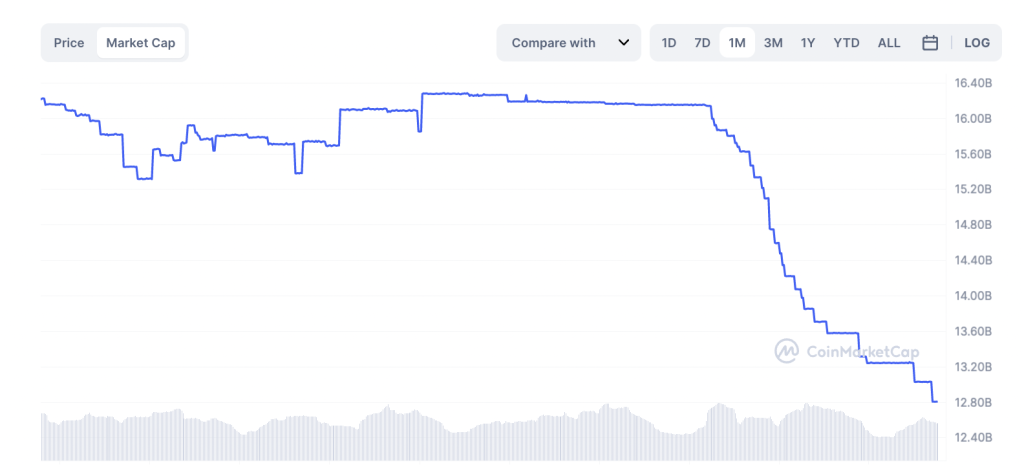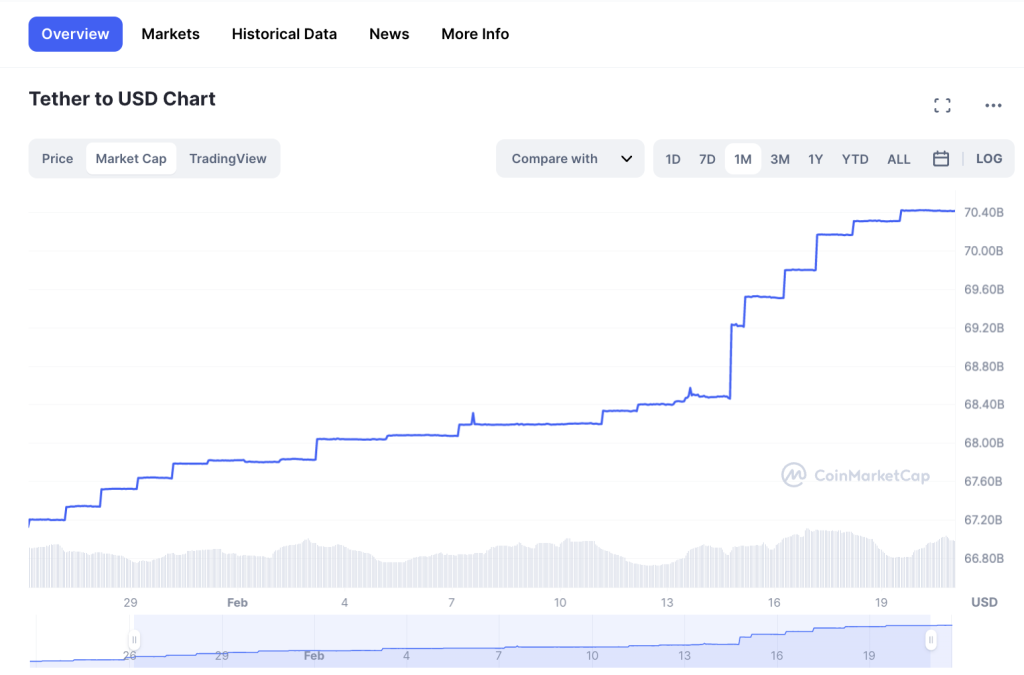Starting from February 21, Paxos will halt the creation of new BUSD tokens as per the directive of the New York Department of Financial Services (NYDFS). In a statement issued on February 13, the leading regulated blockchain and tokenization infrastructure platform announced it will end its relationship with Binance for the branded stablecoin BUSD.
“Paxos Trust, a regulated institution overseen by the NYDFS and audited by a top-four accounting firm, will continue to manage BUSD dollar reserves. All BUSD tokens issued by Paxos Trust have and always will be backed 1:1 with US dollar-denominated reserves, fully segregated and held in bankruptcy remote accounts.”
The recent crackdown on BUSD stablecoin by NYDFS highlights the growing regulatory scrutiny on the crypto industry. This is not the first time regulators have targeted virtual digital assets, and it certainly won’t be the last. Earlier this month, the SEC had accused Payward Ventures, Inc. and Payward Trading Ltd., entities that are part of Kraken, of contravening regulations regarding the offering and sale of their crypto-asset staking-as-a-service program.
What is BUSD impacted?
What makes this case noteworthy is the fact that BUSD, the third-largest stablecoin in the world, had a market cap of over $16B on February 13, the day it announced its decision to halt production. Over the last week, nearly $2.5 billion of market cap has been lost and stood at $12.7 billion at the time of writing (February 21). In a statement issued by Paxos, it stated that it categorically disagrees with the SEC staff because BUSD is not a security under federal securities laws.

BUSD issued by Paxos is always backed 1:1 with US dollar-denominated reserves, fully segregated and held in bankruptcy remote accounts. We will engage with the SEC staff on this issue and are prepared to vigorously litigate if necessary.
NYDFS wants to ensure all stablecoins issued by DFS-regulated entities are required to be fully backed and these reserves are regularly reviewed through third-party attestations and internal and external, independent reviews.
How is Paxos related to Binance?
Launched jointly by Binance and Paxos, BUSD is widely used as a fiat-linked store of value. Unlike its competitors like Tether (USDT) and USD Coin (USDC) which are available on several chains, BUSD is issued on only four blockchains – Ethereum (ETH), BNB Chain (BNB), Polygon (MATIC), and Avalanche (AVAX). Due to its compatibility with four commonly used chains, it is highly suitable for conducting cross-chain value transfers. It is important to note that Paxos does not issue these non-Ethereum versions of BUSD.
According to a report by Bloomberg, Circle Internet Financial, which is Paxos’ main rival and issuer of the USDC stablecoin, shared blockchain data collected by its team with the NYDFS. The data purportedly revealed that Binance was not holding enough reserves to support the number of BUSD tokens it had issued.
In September 2022, Circle, which is also under the regulation of NYDFS, filed a complaint shortly after Binance introduced a new policy that automatically converted all USDC deposits into its BUSD stablecoin. This move significantly reduced Circle’s market share of stablecoin as Binance, being the largest cryptocurrency exchange globally, held a substantial portion of the market.
Auto-Conversion and why was it a concern?
In the Consumer Alert Notice Regarding Paxos-Issued BUSD, DFS has ordered Paxos to cease minting Paxos-issued BUSD as a result of several unresolved issues related to Paxos’ oversight of its relationship with Binance in regard to Paxos-issued BUSD.
What could be those unresolved issues and why NYDFS was concerned about them?
Various reports published by Bloomberg and other media outlets have mentioned Binance acknowledging flaws in the management of its stablecoin’s reserves which at times led to more than $1 billion in missing collateral, according to one analysis. Blockchain analyst Reiter had identified gaps in Binance-peg BUSD. The exchange acknowledged the operational delays but later claimed that they have been resolved now.
In September 2022, Binance introduced BUSD Auto-Conversion, a new feature that automatically converted USDC, USDP, and TUSD balances into BUSD at a 1:1 ratio. In a blog, Binance categorically clarified that the goal was to improve liquidity as well as to provide better prices and faster order executions for our users.
Moreover, Binance creates its own versions of third-party coins like Bitcoin, Ether, USDC, and USDT, known as ‘Binance-peg’ or ‘B-Tokens,’ and deploys them on its BNB Smart Chain. Binance has admitted to failing to maintain 1:1 collateral for these B-tokens. In one instance, it was reported that Binance had only $100 million in collateral to support $1.7 billion in Binance-peg USDC.
While Paxos is licensed to issue BUSD on Ethereum and is required to maintain audited records proving 1:1 backing, Binance issued BUSD on its platform without licensing or proof of reserves. As a regulated U.S. entity, Paxos is responsible for redeeming every BUSD in existence for a U.S. dollar. However, it cannot control the issuance or maintain oversight of the BUSD created on Binance’s platform and blockchain. As Binance is not a U.S. entity, U.S. regulators can only address Paxos’ exposure to this opaque pool of BUSD by banning them from any issuance relationship with Binance.
What will happen to BUSD managed by other blockchains?
The Market Cap of BUSD is close to $13 billion. Over time when Paxos will halt mining, the overall market cap will only decrease.
Binance CEO Changpeng Zhao has already announced on Twitter that they are exploring others and non-USD-based stablecoins.
Aave community member Marc Zeller proposed halting the BUSD lending market on Ethereum.
Following the recent developments between Paxos (minter of BUSD) and the SEC,
Paxos will stop minting BUSD from April 2023 and will only allow redemption for their underlying value by burning BUSD.
The circulating supply of BUSD will thus trend toward zero over time.
This ARFC presents the Aave governance with the opportunity to freeze BUSD reserve on the Aave V2 Ethereum market.
Why Paxos’ halting of mining of BUSD matter?
Stablecoins are becoming increasingly popular, and they are used to facilitate trading and transactions on various cryptocurrency platforms. They are a large part of the crypto ecosystem and every one in four fiat currencies traded, are traded for stablecoins.
It is important to note that stablecoins are traded more than Bitcoin and ETH combine, since they provide a bridge between the traditional financial system and the world of cryptocurrencies, allowing users to trade in fiat currencies without leaving the crypto space.
However, their growing popularity has also raised concerns about their regulatory oversight and their potential impact. This is especially important for stablecoins, which are pegged to fiat currencies and, therefore, have a direct impact on the wider financial system. Regulators are concerned about the potential risks of stablecoins, including their susceptibility to fraud, money laundering, and other criminal activities.
BUSD’s loss = Tether’s gain?
As investors in the cryptocurrency market move away from BUSD, Tether’s USDT, the leading stablecoin in terms of circulating supply, has gained approximately $1 billion in market capitalization. According to CoinGecko, USDT’s market cap has increased from $68.5 billion to $69.5 billion since Monday, marking its highest value since the turmoil in the crypto market last June when traders speculated on the potential downfall of Tether.

Conclusion
The $136 billion stablecoin market is currently undergoing significant changes, as U.S. regulators increase their scrutiny on BUSD and Paxos. The Securities and Exchange Commission (SEC) is reportedly preparing to file a lawsuit against the BUSD issuer for allegedly offering unregistered securities.
In the wake of the BUSD crackdown, other stablecoins are also likely to come under increased regulatory scrutiny. This could lead to a situation where the entire stablecoin market is threatened, and users may be forced to find alternative solutions.
.
